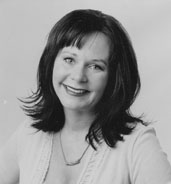 | Laura Oman
is the Director of Education at Xenon International School of Hair Design in Wichita. After working as a full-time cosmetologist for ten years, Laura joined Xenon Int'l, her alma mater, to begin her career as an instructor in educating cosmetology students. This has been her passion for the past five years. Fully licensed in Nevada and Arizona, and Kansas, Laura specialized in all areas of Cosmetology. Ms. Oman can be reached at Xenon International School of Hair Design, 3804 W. Douglas, or by calling (316) 943-5516. |
Beauty & Fashion
2005-02-01 11:24:00
Oily hair solutions
ANSWER: Depending on the cause, there are some ways to help control (but probably not stop) the problem of an oily scalp, which may occur with any type of hair: fine, medium or coarse. Unfortunately thin, fine hair usually is affected the most in appearance because the oil weighs the hair down, resulting in an oilier look. Excessive oiliness is caused by overactive sebaceous (oil) glands. Our oil glands are located in the dermis layer, which is the underlying or inner most layer of the skin. This layer is affected by what is going on inside of our body as the same layer also contains other things like fat cells, sweat glands, blood vessels, lymph vessels, sweat gland hair follicles and our arrector pile muscles (this muscle creates goose bumps). Habits and other things we do, can affect our skin as well, such as: eating habits, drinking enough water, smoking and consuming too much caffeine or alcohol. Any of these can cause your skin to produce too much oil. For example, caffeine and alcohol can have a dehydrating effect which does not allow our skin to slough (shed dead skin cells), resulting in clogged pores and creating an oily feeling on the skin. Hormones can also play a part in the challenge of oily skin or scalp. For teenagers, acne and oily hair are a constant battle. Then there are times that we can't control the things that come to us naturally, through heredity for instance when someone says, "You have the same skin as your mother". Our skin and hair have a pH balance of 4.5 - 5.5. It is best to use products that are the same pH as our skin and hair so that everything remains balanced. The products that we use on our hair or scalp can sometimes be too drying. If we use a cleanser or other products that are a higher pH balance, it can have a drying effect. This can confuse our skin or scalp into thinking that there needs to be more moisture resulting in overactive sebaceous glands. Don't be fooled by over-the-counter products that claim to be "pH balanced" especially if they don't offer the exact pH level on the label. These products could have any level of pH as well as other ingredients that could worsen the issue like waxy substances. For irritating scalp or hair issues it is best to use a professional product that focuses specifically on that problem. Also professional products are pH balanced safely for your hair and scalp. Making regular visits to your stylist or salon for scalp treatments can also help remedy the problem. This involves manipulation of the scalp which can increase blood circulation, bringing the blood to the surface of the scalp; helping the skin to slough and unclog hardened sebum (oil) in the pores of the scalp. In addition it is safe to shampoo your hair daily. Your objective is to remove the oil and improve the appearance of your hair. However, you must consider the products that you choose to use, and the effect they may have on your skin and hair. Overall, taking good care of yourself inside and out is the best solution, and the only one that puts you in control of the results.


